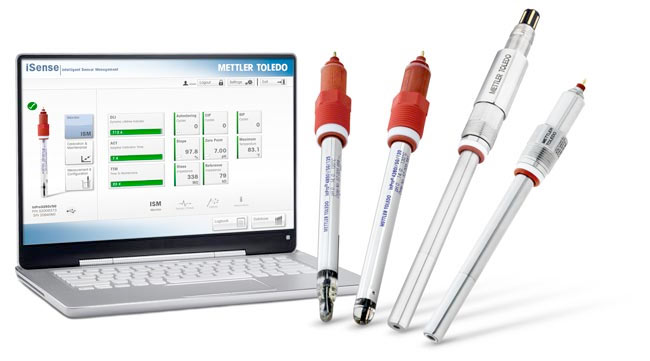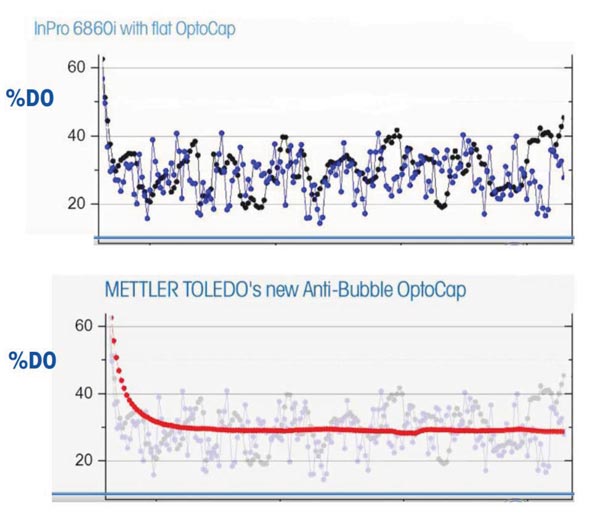Reports
DO & pH Probe Calibration for Optimized Measurement Results in Biopharma
pH and Dissolved Oxygen are critical parameters in bio fermentation and cell culture applications. The proper selection of probes in construction, quality and design is essential. However, to maximize the accuracy of results, it is equally important to utilize the right DO and pH probe calibration and maintenance techniques.
pH Probe Calibration Techniques:
Prior to Autoclaving (or installation on SIP Bioreactor), pH probes must be properly clean and calibrated with two pH buffer solutions (recommended buffer values for maximum stability are 7.00 pH and 4.00 pH or 7.00 pH and 9.21 pH). New digital probe technologies allow performing this pH probe calibration on field transmitters or laptop computers to maximize traceability and diagnostics.
Once installed inside the bioreactor, as the process is initiated, it is normally required to compare the probe pH readings against an external laboratory measurement. For maximum accuracy on the comparison/correction (if required) the temperature of the sample taken to the external device must be as close as possible to that within the bioreactor. Additionally, if sample CO2 degassing takes place, a pH shift will occur, so it is very important to measure the sample immediately after it is extracted from the vessel.

pH Digital Probe Technology
Digital pH sensors represent an evolution of the current “analog” technology. In essence, these probes are identical to the analog ones in materials of construction, dimensions and sensing parts, but include a built-in analog-to-digital converter and internal memory, which transforms them into an integrated smart device. In addition to intelligent diagnostics that could alert the operators of any potential failure during a process run, these probes can be pre-calibrated on a computer, getting them ready to be used at any moment. All pH probe calibration and historical records can then be kept safely stored for optimal management of Lab or GMP suite assets. Accuracy of pH readings are also optimized since noise transmission and signal reduction (common on analog installations) are eliminated. Maximum error is reduced from +/- 0.09 pH to +/- 0.04 pH.
For complete reference data on this subject, please see https://pro-analytics.net/product/ph-orp-sensors/
For more information, check out GOP pH Booklet
Dissolved Oxygen Measurement Technologies
There are currently two primary forms of measurement principles for dissolved oxygen. The first uses the Amperometric method which consists of a platinum cathode / silver anode body that is housed inside an oxygen permeable membrane containing a special electrolyte. The oxygen present diffuses through the membrane, and by applying a constant voltage (600 mV), the O2 is reduced at the cathode. This creates a constant current in the sensor that is directly proportional to the partial pressure of oxygen.
The second and more innovative form of oxygen measurement uses optical technology. This method is based on fluorescence quenching. Sensors that use the optical method flash a green- blue LED light on a chromophore, which absorbs the energy of the light. The molecules in the chromophore go into an excited state and emit red fluorescence – oxygen present around the sensor absorbs energy from the excited chromophore. A detector then compares the phase shift of the fluorescence light to that of a reference LED and provides an accurate dissolved oxygen concentration.
Dissolved Oxygen Probe Calibration Techniques
Typically, DO probes are calibrated prior to new batch runs or when sensor parts are replaced. This includes the change of a membrane body or addition of new oxygen electrolyte in the case of Amperometric probes, or replacement of an Optocap in the case of Optical probes. Amperometric probes need to be polarized for at least six hours prior to calibration. That step is eliminated when using Optical probes. To obtain accurate calibrations, ambient pressure and humidity must be known. Additionally, Pressure and Temperature should be constant during DO probe calibration.
If the probe is installed in a process fermenter, calibration should be performed after the sterilization process, but before inoculation. The dissolved oxygen probe calibration needs to be taken in a medium with a known oxygen saturation content. A one-point calibration is sufficient for most Biopharma process applications. In fermentation, the sensor is calibrated in 100% air saturated medium at process temperature.
For more information check out Optical DO GoP and DO GOP rev D
Bubble Noise in DO Signals
In some cell culture processes, dissolved oxygen readings suffer from signal noise from gas bubbles that enter the measuring area of the sensors. These gas bubbles can cause significant interference in oxygen measurement. Oxygen and air bubbles can create spikes in the oxygen readings whereas nitrogen and carbon dioxide bubbles lower DO measurement signals. This can affect control and the quality of the process.
The answer to this problem is provided with a more hydrophilic “probe tip” that helps to repel gas-bubbles, which results in much reduced bubble signal noise. Mettler Toledo has designed an Anti-Bubble Optocap with a mechanically treated surface and 30-degree angle to optimize the reduction of gas bubble accumulation.
DO & pH Probe Calibration – Optimizing Measurement Results With Anti-Bubble OptoCap

